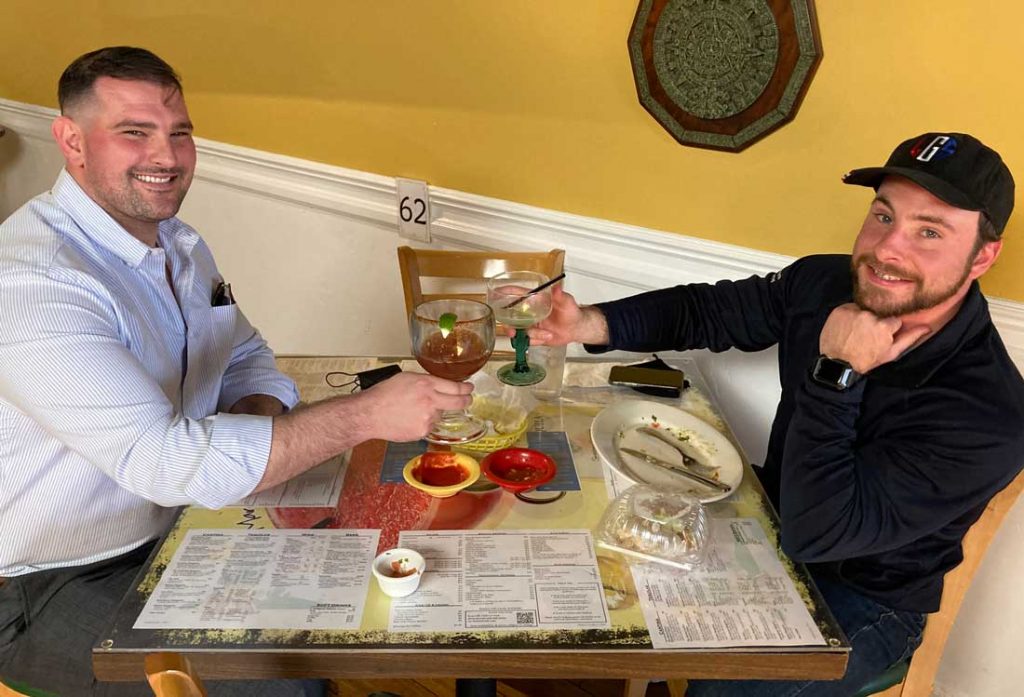Morgan Hill residents and visitors say the return of indoor dining to local restaurants makes them feel almost like life is returning back to “normal,” one year after the Bay Area declared its first wide-ranging shelter-in-place order.
Ron and Brian Hedberg, of Salinas, were eating lunch March 16 at a small table inside Rosy’s At The Beach’s dining room at the corner of Third Street and Monterey Road. Although the restaurant’s tables and chairs are much more spread out than they were before the pandemic—due to continued physical distancing requirements—the Hedbergs said they’re glad to see county and state officials allowing small business owners to accommodate more customers.
“It’s about time, because restaurants have been going through so much,” Brian said. “It’s been bumming me out to see all of them hurting so much. I’m glad we’re getting back to some sort of normalcy.”
The Hedbergs travel through the region often working for their company, Hedberg Construction. Their travels often bring them to various restaurants for lunch, and Ron said when they work in Morgan Hill they usually stop at Rosy’s. But Brian added they have eaten indoors at restaurants only about three times in the last year.
The restrictions, closures and declarations that changed daily life for millions of Bay Area residents began on March 9, 2020, when Santa Clara County health officials announced a ban on gatherings of 1,000 or more people due to the emerging spread of Covid-19.
The announcement threw many large events, such as the Gilroy Garlic Festival and Morgan Hill Mushroom Mardi Gras Festival, into uncertainty.
While it was originally intended as a three-week prohibition, what came next determined the course of 2020. In what they called “a bold, unified step to slow the spread of Covid-19,” public health officials of six Bay Area counties on March 17, 2020 ordered nearly all citizens to “shelter at home” for three weeks. It was later extended.
The legal order limited all individual activity, travel and business functions to only the most essential needs, allowing an exemption for a range of business and services for communities totaling more than 7 million people.
Restaurants were immediately closed for indoor dining, and allowances for outdoor business didn’t come about until several weeks later.
At that time, six people in Santa Clara County had died due to Covid-19, with 155 known cases.
As of March 15, 2021, the county has had 112,749 known cases, with 1,869 deaths.
On March 3, Santa Clara County and the Bay Area entered the “red tier” of Covid-19 risk, opening up more indoor business that was previously closed—including indoor dining at 25 percent capacity. And this week, the governor changed the red tier restrictions to allow wineries, distilleries and breweries to open without having to serve food.
John Garcia, of San Jose, was eating lunch in the dining room of Sinaloa Café March 16 before heading to Clos La Chance winery in San Martin. He said Sinaloa is “the only place” he eats when he visits Morgan Hill.
Also at Sinaloa March 16 were local residents Tim Goulet and Richard Robinson. “It feels like we’re inching back to normal,” Robinson said.

Vaccines and testing
While vaccination numbers continue to rise, those numbers are held back due to the continuing supply issues, officials say. As of March 15, nearly 208,000 county residents have received both doses of the vaccine, representing about 13 percent of residents ages 16 and older.
The eligibility criteria expanded on March 15, with individuals age 16-64 with certain high-risk medical conditions or disabilities able to be vaccinated, dependent on supply, according to health officials.
The low and unpredictable vaccine supply affected several thousand appointments over the past week, according to a statement from the county.
Kaiser Permanente patients that had appointments scheduled with the county health system between March 11-21 were transferred back to Kaiser.
“The County is transferring Kaiser patients’ appointments to Kaiser because the State has assured Kaiser it will have sufficient vaccine for its members and its vaccine sites, while the County has received no such commitment for the uninsured and vulnerable populations we serve,” the statement read.
The county surpassed 3 million Covid-19 tests over the weekend. What started with several hundred tests a day at the start of the shelter-in-place order has now grown to a testing operation that, during the peak winter surge, collected more than 25,000 specimens daily, according to county officials.
“Testing is one of our most important public health tools when it comes to Covid-19. Without it, we are essentially blind to where the virus is and how quickly it is spreading through our community,” said Dr. Marty Fenstersheib, Covid-19 Testing and Vaccine Officer for the county. “We now know so much more about disease transmission and prevention than we did a year ago. But one thing has not changed, and that is the critical role of testing.”
Erik Chalhoub contributed to this report.








